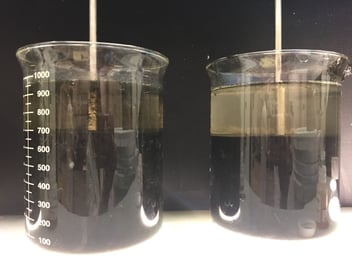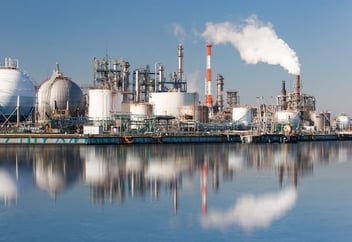Oily Wastewater by Industry
Manufacturers face many challenges pertaining to the pre-treatment of wastewater. In this article, six different industry wastewaters- food and beverage, primary metals, mining and mineral processing, oil and gas (upstream and downstream), automotive, and centralized waste treatment - are examined by how they are formed and what the main contaminants of concern are.
Click HERE to view an infographic of these industries and their contaminants
Food and Beverage
From production of beef, fish, and poultry, to cheese, dairy, edible oils, and prepared foods, many of the wastewater treatment challenges are similar. The cleaning and sanitation processes not only requires the use of varying cleaning and sanitation chemistries, but it also requires large amounts of water. The combination of water, cleaning chemicals, and food residuals from the manufacturing process result in contaminated water often in emulsified form.
The main contaminants of concern are:
- Fats, Oils, and Greases
- Suspended Solids
- Biological Oxygen Demand
- Chemical Oxygen Demand
Primary Metals Contaminants
Primary metal manufacturing such as steel mills, direct reduced iron (DRI) and aluminum rolling mills all rely on the separation of oil and/or solids from water for effective process and wastewater treatment. Process water is defined as water that comes in contact with any raw material, product, by-product or waste during any production or industrial process. This process water is important, since water is used in many different steps of the manufacturing process including during cooling, dust suppression, cleaning, heat treatment, and transferring waste materials. Typically, primary metal plants directly discharge their wastewater, making treatment particularly important.
The most significant contaminants for primary metal wastewater include:
- Suspended Solids
- Oil and Grease
- Heavy Metals:
- Lead
- Zinc
- Chromium
- Nickel
- Iron
Mining and Mineral Processing
Water availability and quality plays an integral role in mining and mineral processing. Process water is used in industrial plants, industrial processes, and production facilities following extensive water pre-treatment such as softening or demineralizing. The objective of treatment of process water is to be able to recycle the water for reuse and feedback into the industrial process. Many applications for sand and construction aggregate require these materials be free of impurities, so they are rinsed or “washed” with water to remove silt and clay particles, which become suspended in the wash water. Wastewater from mining operations must be properly managed to prevent any water or soil pollution arising from leaching of heavy metals. Mining wastewater is often acidic, requiring that lime, limestone, or caustic soda be added to the wastewater to raise its pH. Dissolved metals can then precipitate out of solution and sink to the bottom of settling or sedimentation ponds.
Process water created from the mining and mineral processing industry is commonly contaminated with:
- Suspended Solids
- Salts
- Metals Acids
Oil and Gas Upstream
Water produced during oil extraction, known as upstream operations, constitutes the industry’s most important and voluminous water stream. In some cases, water is a useful by-product or a salable resource as the industry begins to recognize produced water as a potential profit stream. Regardless of the method chosen to extract oil or gas, water is always extracted along with it. It is most important to companies to treat the contaminated water in a way that they will still get the optimal oil recovery, reuse the produced water, and treat the injection water.
Produced water is heavily polluted with:
- Hydrocarbons
- Oil
Oil and Gas Downstream
Wastewater is created at oil refineries since crude oil, the refinery’s main input, contains water from the drilling process. This wastewater is generally difficult to treat, since it is in emulsified form. The crude oil must be separated from the water before being fed to the refining units. If it is not separated, pumps can become clogged and/or corrode, causing issues for the refineries. Any water that comes in contact with crude oil must be treated as wastewater. Wastewater discharges generated by refining and other downstream industrial activities can also be reused once it has been treated, helping to preserve precious water resources.
Water must be treated to remove:
- Oils
- Hydrocarbons
- Hydrogen Sulfide
- Ammonia
- Phenols
- Chemical Oxygen Demand
- Biological Oxygen Demand
Automotive
According to estimations, around 40,000 gallons of water can be required to produce a single vehicle. Automotive and automotive component manufacturing process is fueled by water. Because of this, it is essential to the automotive industry to remove contaminants from the water, to preserve resources and remain sustainable. Wastewater is generated from coolant oil waste, plating operations, baths, and rinses to name a few. Clean water is critical throughout the process. Alongside this, treating paint overspray generates oily wastewater.
Regardless of what step water is used, wastewater in the automotive industry is heavily polluted with:
- Oil
- Suspended Solids
- Greases
- Hydrocarbons
Centralized Waste Treatment
Centralized waste treatment (CWT) facilities focus on the treatment of residuals and industrial process by-products that come from other manufacturing facilities. CWT facilities face the challenge of treating many different water contaminants while having to adhere to all the regulations in place.
To ensure proper treatment, CWT facilities break the types of wastewater into different categories.
.png?width=600&name=ABCs%20of%20CWT%20(2).png)
GreenFloc Natural Coagulants excel at treating wastewater in all of these industries




